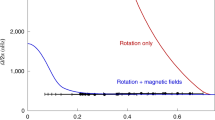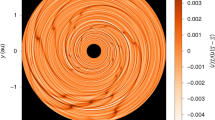Abstract
McCREA1 has recalled the suggestions2,3 that the gravitational energy released by material accreted by the Sun from interstellar clouds could trigger the onset of terrestrial Ice Ages. The purpose of this communication is to point out that if the Hoyle–Lyttleton mass accretion rate applies, this accretion is sufficient to enhance the surface heavy element abundances of the Sun and other solar–type stars. The enhancement may be sufficient to allow the construction of consistent solar models with an interior heavy element abundance significantly lower than the observed surface abundance. This condition lowers the predicted solar neutrino flux4. Joss5 has suggested that a similar enhancement of surface abundances might occur by accretion of planetesimals left over after formation of the Solar System. Both mechanisms may occur, thereby increasing the effect.
This is a preview of subscription content, access via your institution
Access options
Subscribe to this journal
Receive 51 print issues and online access
$199.00 per year
only $3.90 per issue
Buy this article
- Purchase on Springer Link
- Instant access to full article PDF
Prices may be subject to local taxes which are calculated during checkout
Similar content being viewed by others
References
McCrea, W. H., Nature, 255, 607–609 (1975).
Shapley, H., J. Geol., 29, 502–504 (1921).
Hoyle, F., and Lyttleton, R. A., Proc. Camb. phil. Soc. math. phys. Sci., 35, 405–415 (1939).
Bahcall, J. N., Huebner, W. F., Magee, N. H., Jr, Mertz, A. L., and Ulrich, R. K., Astrophys. J., 184, 1–4 (1973).
Joss, P. C., Astrophys. J., 191, 771–774 (1974).
Gordon, M. A., and Burton, W. B., Astrophys. J. (in the press).
Falgarone, E., and Lequeux, J., Astro. Astrophys., 25, 253–260 (1973).
Shu, F. H., et al., Astrophys. J., 173, 557–592 (1972).
Hobbs, L. M., Astrophys. J., 191, 395–399 (1974).
Talbot, R. J., Jr, Butler, D. M., and Newman, M. J., Nature, 262, 561–563 (1976).
Talbot, R. J., Jr, and Arnett, W. D., Astrophys. J., 186, 51–67 (1973).
Bahcall, J. N., Bahcall, N. A., and Ulrich, R. K., Astrophys. J., 156, 559–568 (1969).
Author information
Authors and Affiliations
Rights and permissions
About this article
Cite this article
NEWMAN, M., TALBOT, R. Solar neutrinos and solar accretion of interstellar matter. Nature 262, 559–560 (1976). https://doi.org/10.1038/262559a0
Received:
Accepted:
Issue Date:
DOI: https://doi.org/10.1038/262559a0
This article is cited by
-
Climate and paleoclimate: What we can learn about solar luminosity variations
Solar Physics (1981)
-
Solar neutrinos: Theory versus observation
Space Science Reviews (1979)
-
Spectrum of climatic variations and their causal mechanisms
Geophysical Surveys (1979)
-
Diffusion time scales and accretion in the Sun
Nature (1977)
Comments
By submitting a comment you agree to abide by our Terms and Community Guidelines. If you find something abusive or that does not comply with our terms or guidelines please flag it as inappropriate.



